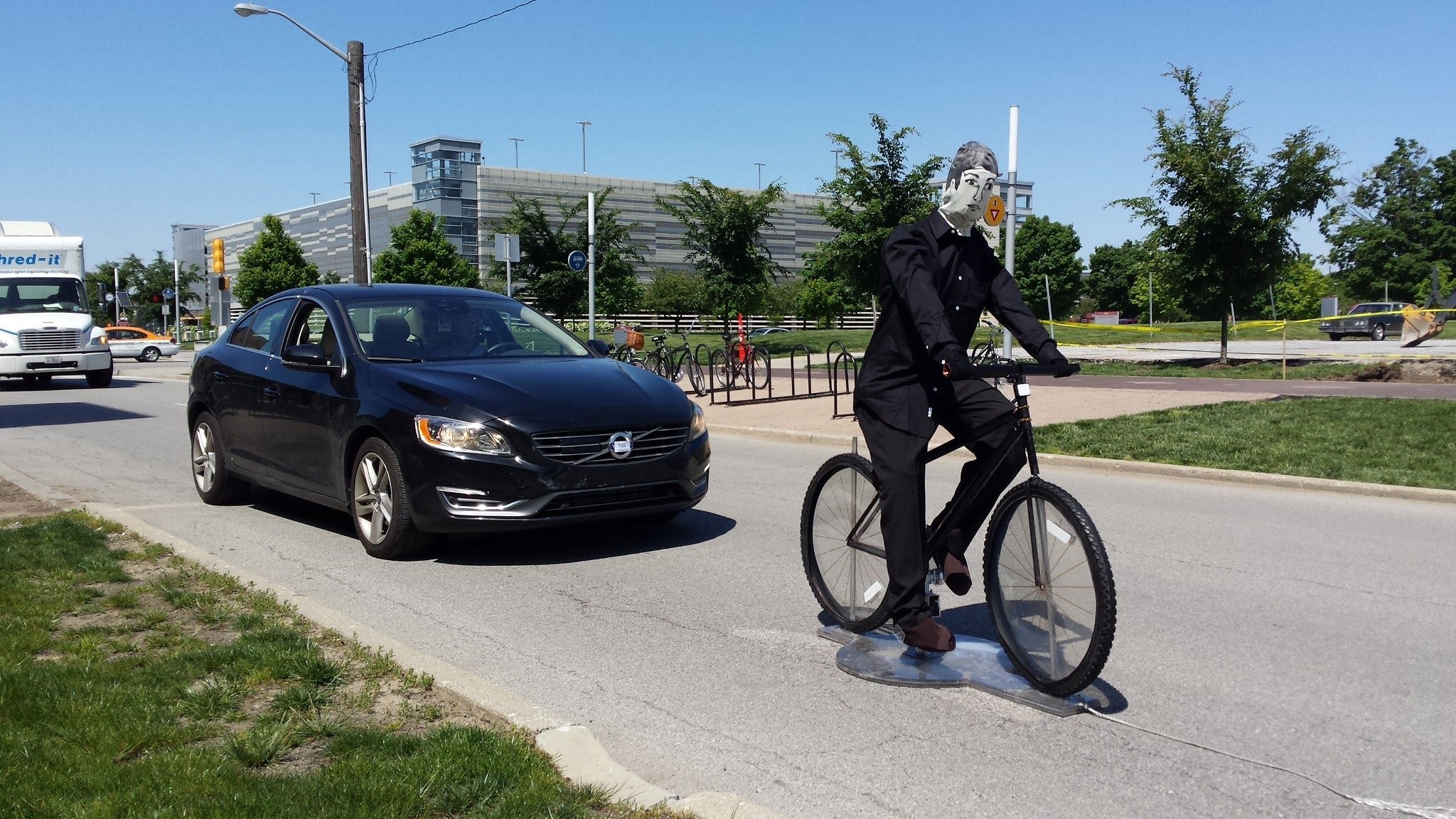IUPUI Keeping Driverless Vehicles ‘On the Road’
 An earlier project led to TASI's creation of a “crash-able” bicyclist mannequin to test automatic emergency braking systems.
An earlier project led to TASI's creation of a “crash-able” bicyclist mannequin to test automatic emergency braking systems.
Subscriber Benefit
As a subscriber you can listen to articles at work, in the car, or while you work out. Subscribe NowAutonomous vehicles are gaining traction with each passing day; the industry is pushing the accelerator on their development, with major auto manufacturers investing heavily in self-driving technology. IUPUI researchers and students are in the driver’s seat for a critical safety feature these future cars must possess: road departure detection and mitigation—basically, detecting if the car is drifting off the street and correcting it. IUPUI leaders say the research, taking place in Indianapolis, is a key step toward your car driving you someday.
The work is taking place at IUPUI’s Transportation Active Safety Institute (TASI), which has partnered with Toyota in the past to create autonomous vehicle technology to prevent pedestrian and bicyclist collisions. Toyota’s Collaboration Safety Research Center (CSRC) is now launching CSRC Next, a five-year, $35 million project that funds work at six universities to address the industry’s grand challenges in transitioning to self-driving cars.
IUPUI’s research will focus on road departure detection and mitigation. While lane departure technology is a relatively common safety feature for current car models, it relies on clear lane markings, which don’t exist on some roadways or may not be visible due to snow or other elements.
“For the next generation of road departure prevention, we will not simply rely on lane markings, but will look at common roadside objects such as grass, electric poles or concrete dividers to detect the boundary between the road and roadside,” says IUPUI electrical and computer engineering graduate student Abir Saha, who is working on the project.
To build the framework for the technology, TASI students and researchers spent 12 months studying road edges—from major interstates to rural roads—in all 50 states, using Google Street View images and other tools.
“The roadside can be very complicated; it could be guardrails, a ditch or concrete blocks,” says TASI Director Dr. Yaobin Chen. “This technology is on current vehicles with a driver…but we’d like to have this as an automation—an autonomous function on vehicles, so this technology will assist the driver in avoiding any crash.”
TASI used the information to create a database of top view and street view images and video to guide the design of its road departure technology; understanding road edges will guide what the vehicles’ sensors should detect. On the vehicle itself, the team is using cameras—including infrared for night vision—radar and LIDAR (Light Detection and Ranging) to identify road edges.
To test the technology, the TASI team is also building what it calls “surrogate objects,” or artificial roadside barriers, that won’t damage the vehicles during testing; Saha says this has been one of the most difficult aspects of the project.
“These concrete dividers or metal guardrails need to look real to the sensors, but be soft and reusable to not cause damage to the cars,” says Saha. “Getting it to work for all the sensors is the tricky part; sometimes, we build something that works for the camera, but not so well for radar or LIDAR. That has really been a big challenge.”
TASI has experience in this area; Chen says the team previously invented one of the industry’s best “crash-able” pedestrian and bicyclist mannequins to test automatic emergency braking systems.
“‘Crash-able’ means, during testing, if you have a high-speed crash, the mannequin can recover within a minute,” says Chen. “You can put it back together again to repeat, so the testing can continue.”
Chen says the Toyota projects place a high priority on education; he notes about 30 students, both undergraduate and graduate, have been involved.
“We’ve learned a lot of things from those real, hardcore [Toyota] engineers—what research and development really means for real-world problem solving,” says Chen. “And secondly, we’re part of this big wave of autonomous driving, autonomous vehicles and artificial intelligence (AI); a lot of our technical research methods are based on machine learning and AI.”
“These are exciting times,” says Saha. “Autonomous driving is getting a lot of industry push in recent years. Driving is part of life in the U.S., so this is something that connects directly to our lives. Making the car move toward a fully-autonomous future is something we’re very excited about. It might be at least a few years from now, but still, we hope we’re getting there.”
Chen says TASI’s latest project with Toyota underscores the importance of safety and showcases IUPUI’s expertise in that area.
Chen says education, both of students and the industry, is an important focus of Toyota’s research projects.
